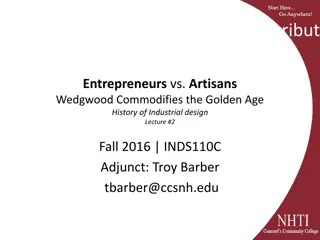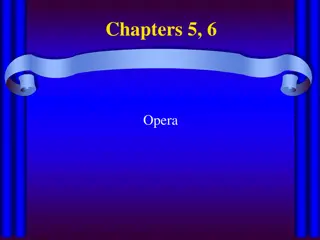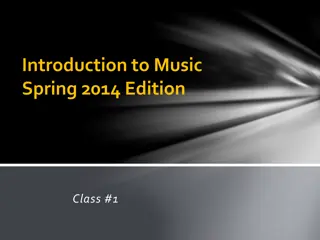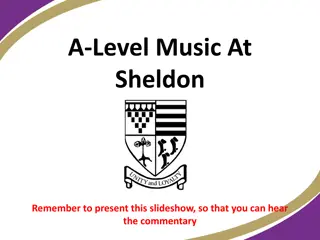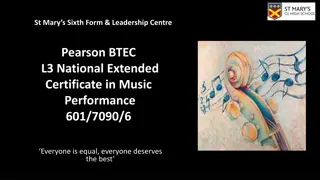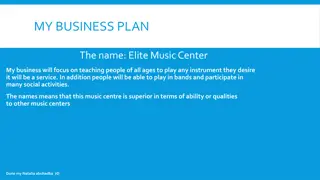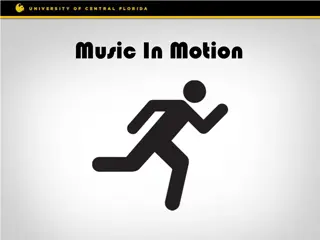Exploring Handel's Water Music Suite in the Baroque Era
Handel's Water Music Suite, composed during the Baroque Era, is a collection of dance movements structured in binary and ternary forms. The suite features standard dances like Allemande, Courante, Sarabande, Gigue, and occasionally Minuet, Gavotte, and Bourée. The suite's movements include Allegro, Hornpipe, Minuet, Lentement, and Bourée, each showcasing unique musical elements. An analysis of the Hornpipe movement reveals distinct sections and melodies characterized by rhythmic patterns and orchestral interplay. Dive into the rich musical features of Water Music through melodic, rhythmic, textural, harmonic, and structural elements.
Download Presentation

Please find below an Image/Link to download the presentation.
The content on the website is provided AS IS for your information and personal use only. It may not be sold, licensed, or shared on other websites without obtaining consent from the author. Download presentation by click this link. If you encounter any issues during the download, it is possible that the publisher has removed the file from their server.
E N D
Presentation Transcript
Water Music G. F. Handel
Background Composed during the Baroque Era 1600 1750 The suite was a common form/structure that composers used at this time. A suite was a collection of dances Each individual dance was usually in two parts binary form AB or in three parts Ternary form ABA
Standard dances in a suite Allemande, Courante, Sarabande, Gigue and sometimes the Minuet, Gavotte and Boure
Water Music This particular suite uses five movements Allegro 1. Hornpipe 2. Minuet 3. Lentement 4. Boure 5.
Contemporary of Handel J.S. Bach would be a composer that you might know as a contemporary of Handel that composed music in the Baroque Era. Tonight Listen on youtube to the first movement of the Cello Suite No. 1 as an example of Baroque composing.
Junior Cert For the JC you only have to study two movements from the Water Music Suite. The Hornpipe and the Minuet. Lets listen to both of them today and get a flavor for the basic musical features of these movements
Musical Features? How does Water Music use the following elements of music in your opinion? Melody Rhythm Texture Harmony Structure/form
Hornpipe This movement is broken into two main different Sections with the form being ABA The first A is called the statement then the B is called an episode while the A is then repeated
The A section (The Statement) A strong and confident opening melody that has 5 bars in total. There is a strong sense of rhythm with leaps and steps ascending up to the climax of the phrase. In bars 6 -11 there is a descending melody on violins and oboes. In bar 11 the trumpets play the opening melody again but it is now only 4 bars long. French horns then play the melody again but are answered by strings, oboe and trumpets. Then at bar 22 to 27 we get the strings again playing at a much higher register while the oboe play a countermelody
Countermelody All music is about texture, whether it s a monk singing on his own in a church, Alex turner singing with the Arctic Monkeys or Handel s water music they all share the element of texture in common. We have three words to describe texture in music or in other words we have three types of musical texture. Monophonic, Homophonic or Polyphonic. Let s listen to understand.
MONOPHONIC EASIEST TO UNDERSTAND MONO MEANING ONE. ONE SOUND! SO IF THERE IS EVER ONE MELODY/SINGER WITHOUT ACCOMPANIMENT THEN IT IS MONOPHONIC. LIKE A PRIEST SINGING ALLELUIA IN THE CHURCH WITHOUT ACCOMPANIMENT THEN THAT IS MONOPHONIC
HOMOPHONIC BASICALLY IT IS ANY MUSIC THAT HAS A MELODY AND ACCOMPANIMENT. MOST OF THE SONGS WE SING IN CLASS HAVE A HOMOPHONIC TEXTURE BECAUSE THERE IS ONE MELODY THAT EVERYONE SINGS AND IT IS ACCOMPANIED BY CHORDS AND CHORDS ONLY. THE PRIEST HAD NO ACCOMPANIMENT THAT IS THE DIFFERENCE BETWEEN MONO AND HOMOPHONIC.
Polyphonic Polyphonic is probably the most difficult to interpret, this texture is when you have more than one melody. You could have accompaniment too, but there might be two or more independent melodies an example of this would be when we sing cannon or rounds in class they are polyphonic because there is more than one important melody. Sometimes when you have two melodies they second one is referred to as a countermelody.













